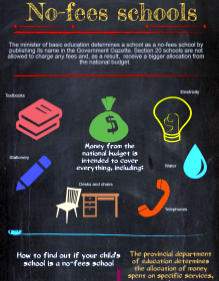|
Getting your Trinity Audio player ready...
|
In our previous article we detailed the roles of principals and school governing bodies in managing a school. In this article we move on to explaining the rules pertaining to the management of funds at no-fee schools.
Like Section 21 schools, no-fee schools are supposed to pay for everything i.e. textbooks, stationary, water, lights, telephone, etc. But in this case, the provincial education departments determine how much of the allocation can be spent on what, such as 10% on municipal services, 8% on maintenance and 45% on learning support materials such as textbooks.
No-fee schools receive a cash amount in lieu of the income they would have received had they been able to charge fees. This money – between 10% and 20% of the total allocation from government – is not subject to the same strict spending restrictions as the rest of the money they get. But it should all be accounted for in annual audited statements.
However, despite this regulation, there is still the risk of abuse of the concept of no-fee schools – for instance, in a tip-off we received at the beginning of this year, the concerned reporter states:
“*** is a no- fee school. In 2007 the leaners paid school fund of R80.00 each – more than 700 learners. That money went directly into the principal’s coffers … The Principal cannot account on how norms and standard money is spent as there is no evidence to that effect. Please assist the community by investigating and exposing this corruption.”
Because not all the money allocated to the school is transferred into its account, the school is expected to draw up a “paper budget”, since the money is available on paper only, which shows how they intend to spend the money they get from the government.
Funds coming into account determined by responsibilities
The percentage that gets transferred to a school’s bank account and which the school can manage varies from province to province, but it depends on the responsibilities the school has.
For example, all no-fee schools in the Western Cape get 20% of their allocation transferred to their bank accounts while all no-fee schools in the Eastern Cape automatically get 10% of their grants.
Eastern Cape schools that have no Section 21 functions will only receive this 10%. The remaining 90% of their funds will be held by the district, and managed as a paper budget.
However, Eastern Cape schools responsible for their own municipal services will have an additional 10% of the money transferred to their bank accounts. And if a no-fee school is responsible for both municipal services and school maintenance, they can expect to have 28% of the allocation transferred to their school bank account.
The remainder of the money is managed by the provincial education department, which uses it to pay for the supply of goods or services to the school.
Procedure for buying goods
To buy goods, no-fee schools typically fill in requisition forms for support materials, such as textbooks, stationary and furniture, etc. The department then orders the items and pays the suppliers or service providers directly.
Schools are required to check and verify all deliveries prior to payment being made.




